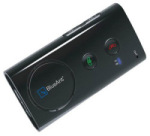Super Bluetooth
Christian Nimsky
BlueAnt Supertooth IIIHere in California as the much publicized cellphone laws have gone into effect I’ve had to start wearing my earbud. All the time. Now while my earbud - a Plantronics 910 - is a great earbud, when I used it in the car previously it was more for when I had a big call to do. Short “yes I’m on my way home” calls didn’t warrant the earbud in my mind.
For the past few weeks I’ve been wearing it religiously and it’s kind of a pain to do that: I don’t like having to carry an earbud and then either be faced with the job of keeping track of the darn thing - they’re small - or wearing it all the time and looking like “one of the earbud people.” Some people still aren’t sure if it’s good to have a transmitter on the side of your head either. So, we bought a portable battery powered bluetooth speakerphone for our two non-speakerphone commuter cars. Our first was a Parrot Minikit, and the other was the BlueAnt Supertooth III.
While there are blueooth speakerphone kits that integrate with your car’s radio system (made by Parrot and other companies) we didn’t want to do anything that invasive, especially not being sure how well they would sound. Both speaker phones are designed to clip onto your car’s visor and go for at least 10 hours of talking between charges. Both sound good and are easy to use. Below are my initial observations after using both speakerphones, focusing on the differences:
Parrott Minikit
- A little bigger than the Supertooth, but may fit on some visors better because its “footprint” is deeper whereas the Supertooth is more horizontal.
- Nice easy to use knob for adjusting volume whereas the Supertooth has volume up/down buttons.
BlueAnt Supertooth III
- Lighter.
- Seems louder than the Parrot, which is a plus in noisy cars. If you have an ultra-quiet luxury sedan this won’t be a problem but then your luxury sedan probably has bluetooth in it already.
- The clip attaches/detaches via a magnet to the Supertooth which I like BUT on cars with “poofy” visors it means your Supertooth’s magnets may not fully click into the clip because the visor’s padding may separate the Supertooth from the low-profile clip. Fortunately the Supertooth’s magnets are strong so it still clings pretty good.
- While both have an auto-off if they lose your phone’s signal the Supertooth also has an “auto on” - when it senses vibration in your car (e.g. as you close the door) it wakes up just enough to look for your phone. If it finds your phone it then powers up and connects. This is a really cool feature and also works if you are on your phone when you walk up to your car — it will switch over automatically.
- Supertooth can announce callers by name or caller ID by syncing with your phone’s address book and doing text-to-speech. Not sure if the Minikit can do that. Although the Supertooth’s pronounciation is not perfect (not is it’s address book syncing) it is nice to have a sense of who is calling you.
- The Supertooth’s Send/End buttons are more clearly labeled than the Parrot’s. The Parrot’s blink either red or green depending on the buttons but during the day it’s hard to see that blink and tell which button does what. The Supertooth is very clearly labeled.
- Both have a voice dial capability but I haven’t tried that yet.
Summary: I really like the Supertooth and now my wife feels I shorted her with the Parrot since we bought that first for her car. The Parrot is not a bad speakerphone at all but we’ll probably end up buying another Supertooth and relegating the Parrot to our 3rd car.
